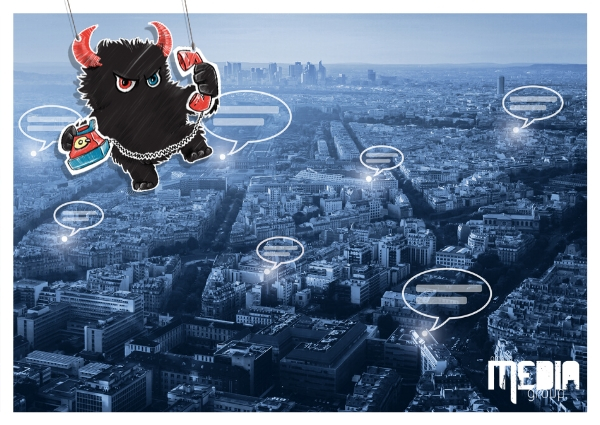 https://www.omahamediagroup.com/images/uploads/monster_gallery/Omaha-Media-Group-Black.jpg
admin
https://www.omahamediagroup.com/images/uploads/monster_gallery/Omaha-Media-Group-Black.jpg
admin
Remote working: How to effectively communicate with employees

Communication is one of the most important notions in business, but communication is not always as effective as it should be, and remote communication can be especially challenging. During this COVID-19 Pandemic, a number of companies including Monstrous Media Group, have transitioned to remote working spaces.
However, as this is new to our company and so many others, it is critical to understand the importance of communication with remote workers. Here are seven tips to keep communication clear and effective.
1. Define goals and expectations
The first and foremost step is defining goals and expectations with employees. This is part of an effective remote team working relationship because it provides a clear understanding of what is still expected of employees when they are working remotely. A company should send all employees a guideline that states the expectations of their employees which allows for employees to refer back to at any moment to clarify any confusion or misunderstanding.
The goals that are defined for each remote employee will change depending on their position, but smaller goals should be set to ultimately reach a bigger goal at the end.
If there is a major project that is launching in the next couple of weeks, what are the smaller items that need to be done first? Content? QA? Bug testing? Client approval?
As a leader or manager, never assume that employees fully understand what is expected of them. It is important to lay a roadmap out for your employees that will help keep communication open and minimize confusion or miscommunication.
2. Virtual meetings
Trust is something that is not given easily, but a company has to trust their employees when it comes to remote working. Part of effective remote team working is virtual meetings because these meetings allow for a company to see their employee’s faces and even read their body language when asked about a task at hand. This also allows employees to ask questions with one another face to face.
An employee might be struggling to ask for help or ask a question because it might come off differently in Slack or email than in person. A virtual meeting allows for collaboration and effective communication to avoid any mistrust or misunderstandings.
3. Brief is not always better
“Wow, 20 minute meeting, how awesome!” As the Harvard Business Review states, “in our efforts to be efficient, we sometimes use fewer words to communicate. But such brevity can mean that the rest of the team waste time trying to interpret your message.” Just because the meeting was only 20 minutes, does it mean that it was successful? Possibly or possibly not.
While everyone has been in meetings where they seem to last an eternity, it is important to not skimp on details because it seems more efficient to be brief. Have an hour meeting with plenty of time for questions and answers, it won’t kill you. We promise that.
4. Skip communication on EVERY platform
No one will deny that the importance of communication with remote workers is essential to the success of the company, but this is where a leader or manager can start overcommunicating and having employees feel as if they are being micromanaged.
Do not send an update on email, slack, text or virtual meeting channels. Pick one or two and stick with it. Check in with remote workers, but do not check in so much that they feel as if you are watching their every move. There is an art to communication and this is one tip to take seriously. Let’s paint the next Picasso painting, not the street corner painting you buy for $20.00.
5. Manage by objectives
Management by objectives (MBO) is the process of defining goals set by the company and understanding how to delegate and turn these goals into successes. From here, a company can determine a team’s and individual’s overall goals for the company.
A company wants to generate X amount in sales over the next year, but what are the objectives for each team and their members? What will sales work on? What will marketing work on? What tools and guidance does the company need to provide to hit these goals?
This can be an efficient and effective way to manage remote workers for longer durations of time or when a company is ready to hire a full-time remote worker.
The importance of communicating with remote workers with an MBO approach is that the employees understand their overall arching goals and objectives that the company has set for the entire company. An employee can start to set their own milestones to help the company reach these goals, and during all these milestones, communicate with management and team members for help, questions, clear confusion and more.
6. Minimize distractions
There are people who kill it while working at home, and others not so much. For some employees, it can be extremely distracting to work from home when laundry needs to be done and the house is a disaster. However, management and leaders should communicate ways that an employee can minimize distractions in their spaces.
While some distractions are inevitable, one distraction could be messages from you! It is important to know when the best time to send a message is. If an employee is working on an extremely important project, and the deadline is approaching, please do not slack them asking about lunch. Do not be the distraction.
Here are some other examples of minimizing distractions:
Set a defined workspace: In this workspace, family members and significant others understand that this space is your office. Just like at the physical office, they can speak with you during lunch and a brief phone call, but cannot simply come in and distract you.
Take breaks: Yes breaks are important. A great book every person in their career should read is, “When: The Scientific Secrets of Perfect Timing.” This book lays out our natural rhythmic clocks, and how each of us lands in three groups.
Within these three groups, we have an internal clock that our bodies follow. Feel sluggish at 2:30? There could be more of a reason than it being the “2:30 blues.” In this book, Daniel Pink breaks down the importance of frequent 20 minutes breaks and explains that these breaks are imperative to the success of an employee and their work day.
7. Communicate effectively
Is this a trick? Nope. Just because employees, managers and supervisors are all “communicating” with one another does not qualify it as effective. It is important that these people all effectively communicate with one another on effective channels.
Just because everyone is using a software such as Slack, does not mean it is effectively getting the point across. Call them. Jump on Zoom or even send an email which allows for a much further in-detailed explanation.
As more and more of our interactions turn digital, it is important to understand clear communication on a day-to-day basis. And as humans, we will miscommunicate but that is just part of life! It is important to help reduce that while working remotely and once we all get back to the office.
Hire the team to help you with your website, app, or other marketing needs.
We have a team of digital marketers who can help plan and bring to life all your digital marketing strategies. They can help with social media marketing, email marketing, and digital advertising!
CONTACT US

Comments